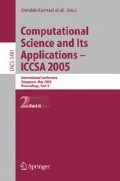Abstract
Congested traffic shows very complicated and stochastic features. One of the most interesting features is the amplification/decay of perturbations, indicating the development of small speed oscillation in the downstream into the large speed oscillation in the upstream. While traffic theories attempt to explain this phenomenon, the mechanism of the speed oscillation is not yet clear in the aspect of drivers’ behavior. Similar phenomenon is also found in a long waiting line such as in front of the stadium or theater ticket box. In this paper, the stop-and-go movement in the waiting line, which is relatively easy to understand than the vehicular movement, is modeled and simulated. From the simulation, it is found that the amplification/decay of perturbation exists in the waiting line and shows similar pattern as in the vehicular movement.
Access this chapter
Tax calculation will be finalised at checkout
Purchases are for personal use only
Preview
Unable to display preview. Download preview PDF.
References
Chandler, R.E., Herman, R., Montroll, W.: Traffic Dynamics: Studies in Car- Following. Operations Research 6, 165–184 (1958)
Edie, L.C., Baverez, E.: Generation and propagation of Stop-Start traffic waves, Vehicular Traffic Science. In: Proceedings of the third international symposium on the theory of traffic flow, pp. 26–37 (1967)
Herman, R., Montroll, E.W., Potts, R.B., Rothery, R.W.: Traffic Dynamics: Analysisof Stability in Car Following. Operation Research (7), 86–106 (1959)
Lighthill, M.J., Whitham, J.B.: On kinematic waves II: A theory of traffic flow on long crowded roads. Proceedings of the Royal Society A 229, 317–345 (1955)
May, A.D.: Traffic Flow Fundamentals. Prentice-Hall Inc., Englewood Cliffs (1990)
Mika, H.S., Kreer, J.B., Yuan, L.S.: Dual mode behavior of freeway traffic. Highway Research Record 279, 1–12 (1969)
Payne, H.J.: Models of freeway traffic and control, Simulation Councils. Proc. Series: Mathematical Models of Public Systems 1(1), 51–61 (1971)
Zhang, H.M.: A Theory of Non-equilibrium Traffic Flow. Transportation Research Part B 32, 485–498 (1998)
Author information
Authors and Affiliations
Editor information
Editors and Affiliations
Rights and permissions
Copyright information
© 2005 Springer-Verlag Berlin Heidelberg
About this paper
Cite this paper
Son, B., Kim, T., Lee, Y. (2005). A Simulation Model of Congested Traffic in the Waiting Line. In: Gervasi, O., et al. Computational Science and Its Applications – ICCSA 2005. ICCSA 2005. Lecture Notes in Computer Science, vol 3481. Springer, Berlin, Heidelberg. https://doi.org/10.1007/11424826_93
Download citation
DOI: https://doi.org/10.1007/11424826_93
Publisher Name: Springer, Berlin, Heidelberg
Print ISBN: 978-3-540-25861-2
Online ISBN: 978-3-540-32044-9
eBook Packages: Computer ScienceComputer Science (R0)

